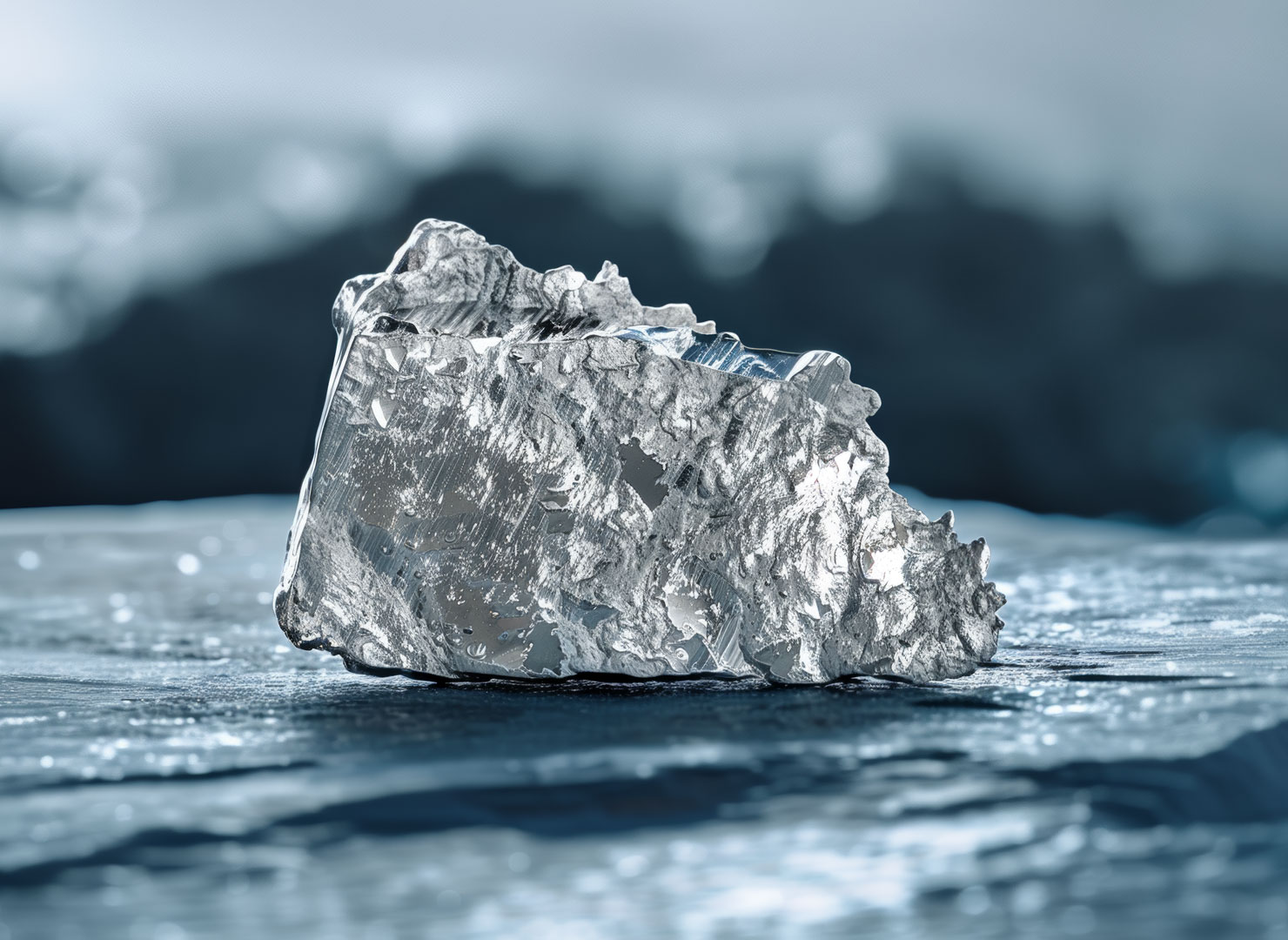The Element Scandium
On this page you can find out more about the rare earth element
Name: Scandium
Symbol: Sc
Ordinal number: 21
Density: 2,99 g/cm3
Melting point: 1.541 °C
Boiling temperature: 2.831 °C
Scandium is one of the transition metals in the periodic table.
Introduction
Green Energy: Scandium as an Important Building Block for the Energy Transition
Scandium is one of the rare earth elements with a high supply risk due to the metal’s small market size and a potentially sharp increase in demand for the material due to hydrogen technologies. To support the generation of green electricity, demand for scandium could almost quadruple by 2040.

The Discovery of Scandium Spanned 66 Years
In 1871, the Russian chemist Dmitri Ivanovich Mendeleev predicted the existence of an unknown element between calcium and titanium in the periodic table, the famous reference to the elements he played a key role in developing. Lars Fredrik Nilson, a chemist from the University of Uppsala in Sweden, discovered the then-unknown scandium in 1879. Nilson extracted scandium from euxenite, a complex mineral containing eight metal oxides. Nilson named his discovery “scandium” after the Latin name of his Nordic homeland, Sweden. However, it was not until 1937 that the rare earth element was extracted in metallic form by the German chemists Werner Fischer, Karl Brünger, and Hans Grieneisen using electrolysis from a melt that contained lithium, potassium, and scandium chloride.
Main areas of application for scandium

The Discoverer of Scandium
Lars Fredrik Nilson, chemist and discoverer of the element scandium, lived in Sweden from 1840 to 1899. Among other things, Nilson was a professor at the University of Uppsala. In addition to his successes in chemistry, he also made significant contributions to Swedish agricultural science and was head of the Agricultural Chemical Experiment Station in Stockholm.
Characteristics
Scandium Is Similar to Aluminum in Weight and Appearance
The silvery metal scandium tarnishes in air and turns slightly yellowish. It is similar to aluminum in weight and appearance. Together with yttrium, scandium occupies a special position within the rare earths: although both have similar chemical and physical properties, their atomic structure differs from the other rare earths, which are known as lanthanides.
Areas of Application
An Important Element for Fuel Cell Technology
The most important use for scandium is in fuel cell technology, as the rare earth metal enables electricity to be generated using chemical processes. The best-known application is the hydrogen-oxygen fuel cell found in a variety of vehicles. More and more, industry is using fuel cells as an energy source. In this context, solid oxide fuel cellsSolid oxide fuel cells: Energy converters that can be operated with hydrogen, biomethane, or natural gas, among other things. (SOFC) are used and scandium-doped zirconium dioxide is used as the electrolyte. Demand for scandium for fuel cells alone amounted to around 55% of global scandium production in 2018. According to calculations by the German Mineral Resources Agency (DERA), demand in 2040 could be 2.7 times the production of 2018.
Scandium is also used in several other areas — for example, in lighting technology, as it produces a daylight-like light. The aviation industry also values aluminum-scandium alloys due to their high stability and low weight.

Water Electrolysis
Green hydrogen is showing great promise as a fuel that can make energy-intensive industries and heavy goods transport more climate-friendly. It is produced by the electrolysis of water using green electricity from nuclear plants or renewable sources. The ramp-up of the hydrogen economy is increasing the demand for rare earths used in electrolyzers.
Learn more

Lighting
Rare earths are used to produce classic fluorescent tubes, modern energy-saving lamps, and LED lights. The raw materials are also used in devices with picture tubes, tablets, and smartphones, where they produce red pixels.
Learn more

Aviation
Metal alloys containing rare earths are used in wings and fuselages to make aircraft lighter. Lighter aircraft use less fuel and have a greater range. However, rare earths are most commonly used in permanent magnets found in auxiliary motors in aircraft electronics and the motors of landing gear.
Learn more

Metal Alloys
Metal alloys are compounds of metallic materials. Modern alloys often contain rare earths to improve specific properties. Rare earth alloys are used in aircraft engines and flints in lighters, among other products.
Learn more
Deposits
Scandium Demand Could Almost Quadruple According to Study
The silvery-white scandium does not occur in elementary form but is found in small quantities in over 800 minerals. As an accompanying element, scandium occurs in these minerals in minute amounts of around 0.5 to 100 ppm. The most important scandium-bearing ore is thortveititeRarely occurring, hard mineral named after the Norwegian geologist Olaus Thortveit.. The exact annual extraction volume cannot be clearly defined due to inconsistent data. Various sources indicate annual production volumes of around ten to 20 tons of scandium; the German Mineral Resources Agency (DERA) assumed 14 to 16 tons in 2021. China was the top producer in 2021, turning out ten tons of scandium, or more than 75 percent of global production. Like the other rare earth elements, scandium is only extracted as a by-product during the extraction processes for iron ore, titanium, zirconium, uranium, cobalt, nickel, and apatite due to the low concentrations in which it primarily occurs.

Significantly Higher Production Volume Possible
According to the German Mineral Resources Agency (DERA), a significant increase in the annual global production volume of scandium seems feasible in the medium term. However, it remains to be seen whether the growing demand for hydrogen technologies such as electrolysis and fuel cells can be met, as the relatively low production volumes and high price have so far prevented widespread use. According to DERA, demand could rise to up to 72 tons by 2040 due to fuel cells alone.
Raw Materials Trading Industrial Customers
TRADIUM trades in all industrially relevant rare earth oxides. Choose from a wide range of specifications and take advantage of the option to reserve batches for the long term.
Purchase of Physical Assets for Private Customers
Benefit as a private customer from the exciting market for rare earths as a physical asset. You can find out here what opportunities TRADIUM offers and what tax advantages a purchase of raw materials entails.